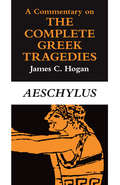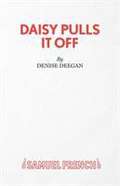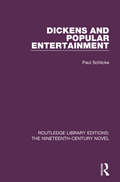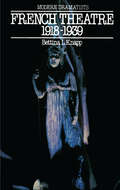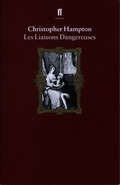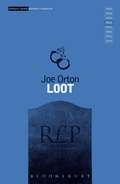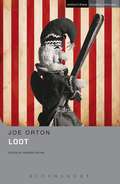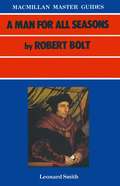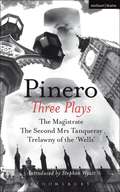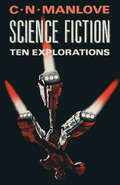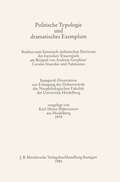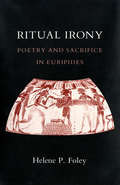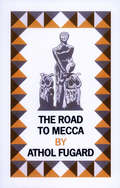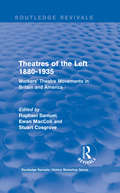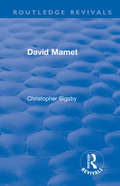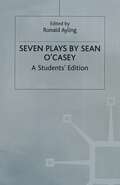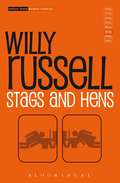- Table View
- List View
A Commentary on The Complete Greek Tragedies. Aeschylus: Aeschylus
by James C. HoganThis commentary offers a rich introduction and useful guide to the seven surviving plays attributed to Aeschylus. Though it may profitably be used with any translation of Aeschylus, the commentary is based on the acclaimed Chicago translations, The Complete Greek Tragedies, edited by David Grene and Richmond Lattimore. James C. Hogan provides a general introduction to Aeschylean theater and drama, followed by a line-by-line commentary on each of the seven plays. He places Aeschylus in the historical, cultural, and religious context of fifth-century Athens, showing how the action and metaphor of Aeschylean theater can be illuminated by information on Athenian law athletic contests, relations with neighboring states, beliefs about the underworld, and countless other details of Hellenic life. Hogan clarifies terms that might puzzle modern readers, such as place names and mythological references, and gives special attention to textual and linguistic issues: controversial questions of interpretation; difficult or significant Greek words; use of style, rhetoric, and commonplaces in Greek poetry; and Aeschylus's place in the poetic tradition of Homer, Hesiod, and the elegiac poets. Practical information on staging and production is also included, as are maps and illustrations, a bibliography, indexes, and extensive cross-references between the seven plays. Forthcoming volumes will cover the works of Sophocles and Euripides.
A Commentary on The Complete Greek Tragedies. Aeschylus: Aeschylus
by James C. HoganThis commentary offers a rich introduction and useful guide to the seven surviving plays attributed to Aeschylus. Though it may profitably be used with any translation of Aeschylus, the commentary is based on the acclaimed Chicago translations, The Complete Greek Tragedies, edited by David Grene and Richmond Lattimore. James C. Hogan provides a general introduction to Aeschylean theater and drama, followed by a line-by-line commentary on each of the seven plays. He places Aeschylus in the historical, cultural, and religious context of fifth-century Athens, showing how the action and metaphor of Aeschylean theater can be illuminated by information on Athenian law athletic contests, relations with neighboring states, beliefs about the underworld, and countless other details of Hellenic life. Hogan clarifies terms that might puzzle modern readers, such as place names and mythological references, and gives special attention to textual and linguistic issues: controversial questions of interpretation; difficult or significant Greek words; use of style, rhetoric, and commonplaces in Greek poetry; and Aeschylus's place in the poetic tradition of Homer, Hesiod, and the elegiac poets. Practical information on staging and production is also included, as are maps and illustrations, a bibliography, indexes, and extensive cross-references between the seven plays. Forthcoming volumes will cover the works of Sophocles and Euripides.
A Commentary on The Complete Greek Tragedies. Aeschylus: Aeschylus
by James C. HoganThis commentary offers a rich introduction and useful guide to the seven surviving plays attributed to Aeschylus. Though it may profitably be used with any translation of Aeschylus, the commentary is based on the acclaimed Chicago translations, The Complete Greek Tragedies, edited by David Grene and Richmond Lattimore. James C. Hogan provides a general introduction to Aeschylean theater and drama, followed by a line-by-line commentary on each of the seven plays. He places Aeschylus in the historical, cultural, and religious context of fifth-century Athens, showing how the action and metaphor of Aeschylean theater can be illuminated by information on Athenian law athletic contests, relations with neighboring states, beliefs about the underworld, and countless other details of Hellenic life. Hogan clarifies terms that might puzzle modern readers, such as place names and mythological references, and gives special attention to textual and linguistic issues: controversial questions of interpretation; difficult or significant Greek words; use of style, rhetoric, and commonplaces in Greek poetry; and Aeschylus's place in the poetic tradition of Homer, Hesiod, and the elegiac poets. Practical information on staging and production is also included, as are maps and illustrations, a bibliography, indexes, and extensive cross-references between the seven plays. Forthcoming volumes will cover the works of Sophocles and Euripides.
A Commentary on The Complete Greek Tragedies. Aeschylus: Aeschylus
by James C. HoganThis commentary offers a rich introduction and useful guide to the seven surviving plays attributed to Aeschylus. Though it may profitably be used with any translation of Aeschylus, the commentary is based on the acclaimed Chicago translations, The Complete Greek Tragedies, edited by David Grene and Richmond Lattimore. James C. Hogan provides a general introduction to Aeschylean theater and drama, followed by a line-by-line commentary on each of the seven plays. He places Aeschylus in the historical, cultural, and religious context of fifth-century Athens, showing how the action and metaphor of Aeschylean theater can be illuminated by information on Athenian law athletic contests, relations with neighboring states, beliefs about the underworld, and countless other details of Hellenic life. Hogan clarifies terms that might puzzle modern readers, such as place names and mythological references, and gives special attention to textual and linguistic issues: controversial questions of interpretation; difficult or significant Greek words; use of style, rhetoric, and commonplaces in Greek poetry; and Aeschylus's place in the poetic tradition of Homer, Hesiod, and the elegiac poets. Practical information on staging and production is also included, as are maps and illustrations, a bibliography, indexes, and extensive cross-references between the seven plays. Forthcoming volumes will cover the works of Sophocles and Euripides.
A Commentary on The Complete Greek Tragedies. Aeschylus
by James C. HoganThis commentary offers a rich introduction and useful guide to the seven surviving plays attributed to Aeschylus. Though it may profitably be used with any translation of Aeschylus, the commentary is based on the acclaimed Chicago translations, The Complete Greek Tragedies, edited by David Grene and Richmond Lattimore. James C. Hogan provides a general introduction to Aeschylean theater and drama, followed by a line-by-line commentary on each of the seven plays. He places Aeschylus in the historical, cultural, and religious context of fifth-century Athens, showing how the action and metaphor of Aeschylean theater can be illuminated by information on Athenian law athletic contests, relations with neighboring states, beliefs about the underworld, and countless other details of Hellenic life. Hogan clarifies terms that might puzzle modern readers, such as place names and mythological references, and gives special attention to textual and linguistic issues: controversial questions of interpretation; difficult or significant Greek words; use of style, rhetoric, and commonplaces in Greek poetry; and Aeschylus's place in the poetic tradition of Homer, Hesiod, and the elegiac poets. Practical information on staging and production is also included, as are maps and illustrations, a bibliography, indexes, and extensive cross-references between the seven plays. Forthcoming volumes will cover the works of Sophocles and Euripides.
A Commentary on The Complete Greek Tragedies. Aeschylus: Aeschylus
by James C. HoganThis commentary offers a rich introduction and useful guide to the seven surviving plays attributed to Aeschylus. Though it may profitably be used with any translation of Aeschylus, the commentary is based on the acclaimed Chicago translations, The Complete Greek Tragedies, edited by David Grene and Richmond Lattimore. James C. Hogan provides a general introduction to Aeschylean theater and drama, followed by a line-by-line commentary on each of the seven plays. He places Aeschylus in the historical, cultural, and religious context of fifth-century Athens, showing how the action and metaphor of Aeschylean theater can be illuminated by information on Athenian law athletic contests, relations with neighboring states, beliefs about the underworld, and countless other details of Hellenic life. Hogan clarifies terms that might puzzle modern readers, such as place names and mythological references, and gives special attention to textual and linguistic issues: controversial questions of interpretation; difficult or significant Greek words; use of style, rhetoric, and commonplaces in Greek poetry; and Aeschylus's place in the poetic tradition of Homer, Hesiod, and the elegiac poets. Practical information on staging and production is also included, as are maps and illustrations, a bibliography, indexes, and extensive cross-references between the seven plays. Forthcoming volumes will cover the works of Sophocles and Euripides.
Daisy Pulls It Off (Acting Edition Series (PDF))
by Denise DeeganDaisy Meredith, the new girl, is the first scholarship student to attend the Grangewood School for Girls. The privileged students are determined to make Daisy look bad in the eyes of the administration. The administration has its own problems, financial ones. Daisy wins over her chums and saves the school when she cracks a secret code, finds a treasure and saves the life of her chief nemesis all on the same night!
Dickens and Popular Entertainment (Routledge Library Editions: The Nineteenth-Century Novel)
by Paul SchlickeFirst published in 1985. Dickens was a vigorous champion of the right of all men and women to carefree amusements and dedicated himself to the creation of imaginative pleasure. This book represents the first extended study of this vital aspect of Dickens’ life and work, exploring how he channelled his love of entertainment into his artistry. This study offers a challenging reassessment of Nicholas Nickleby, The Old Curiosity Shop and Hard Times. It shows the importance of entertainment to Dickens’ journalism and presents an illuminating perspective on the public readings which dominated the last twelve years of his life. This book will be of interest to students of literature.
Dickens and Popular Entertainment (Routledge Library Editions: The Nineteenth-Century Novel)
by Paul SchlickeFirst published in 1985. Dickens was a vigorous champion of the right of all men and women to carefree amusements and dedicated himself to the creation of imaginative pleasure. This book represents the first extended study of this vital aspect of Dickens’ life and work, exploring how he channelled his love of entertainment into his artistry. This study offers a challenging reassessment of Nicholas Nickleby, The Old Curiosity Shop and Hard Times. It shows the importance of entertainment to Dickens’ journalism and presents an illuminating perspective on the public readings which dominated the last twelve years of his life. This book will be of interest to students of literature.
Les Liaisons Dangereuses
by Christopher HamptonThe scandalous reputation of Laclos's novel, first published in 1782, is based on its chilling portrayal of the mannered decadence and sexual cynicism of the French aristocracy in the last years of the ancien regime. Christopher Hampton has made a masterful adaptation for the stage of the conspiracy to corrupt a young girl barely out of her convent.Les liaisons dangereuses was premiered by Royal Shakespeare Company at The Other Place, Stratford-upon-Avon, on 24 September 1985, and won Christopher Hampton the Evening Standard Award for Best Play and the Laurence Olivier Award for Best New Play in 1986.
Loot: The Ruffian On The Stair; Entertaining Mr. Sloane; The Good And Faithful Servant; Loot; The Erpingham Camp; Funeral Games; What The Butler Saw (Modern Classics)
by Joe OrtonA black farce masterpiece, Loot follows the fortunes of two young thieves, Hal and Dennis. Dennis is a hearse driver for an undertaker. They have robbed the bank next door to the funeral parlour and have returned to Hal's home to hide-out with the loot. Hal's mother has just died and the pair put the money in her coffin, hiding the body elsewhere in the house. With the arrival of Inspector Truscott, the thickened plot turns topsy-turvy. Playing with all the conventions of popular farce, Orton creates a world gone mad and examines in detail English attitudes at mid-century. The play has been called a Freudian nightmare, which sports with superstitions about death - and life. It is regularly produced in professional and amateur productions.First produced in London in 1966, LOOT was hailed as "the most genuinely quick-witted, pungent and sprightly entertainment by a new, young British playwright for a decade" (Sunday Telegraph)
Loot: The Ruffian On The Stair; Entertaining Mr. Sloane; The Good And Faithful Servant; Loot; The Erpingham Camp; Funeral Games; What The Butler Saw (Student Editions)
by Joe OrtonA black farce masterpiece, Loot follows the fortunes of twoyoung thieves, Hal and Dennis. Dennis is a hearse driver for anundertaker. They have robbed the bank next door to the funeral parlourand have returned to Hal's home to hide-out with the loot. Hal's motherhas just died and the pair put the money in her coffin, hiding the bodyelsewhere in the house. With the arrival of Inspector Truscott, thethickened plot turns topsy-turvy. Playing with all the conventions ofpopular farce, Orton creates a world gone mad and examines in detailEnglish attitudes at mid-century. The play has been called a Freudiannightmare, which sports with superstitions about death - and life. Itis regularly produced in professional and amateur productions. First produced in London in 1966, Loot was hailed as "themost genuinely quick-witted, pungent and sprightly entertainment by anew, young British playwright for a decade" (Sunday Telegraph).The Student Edition offers a plot summary, full commentary, characternotes and questions for study, besides a chronology and bibliography.
Pinero: The Magistrate; The Second Mrs Tanqueray; Trelawny of the 'Wells' (World Classics)
by Sir Arthur PineroBorn within a year of both Shaw and Wilde, Pinero was one of the most popular - and prolific - playwrights of his age. This volume contains his three best - and still most often performed - plays, each written in a different mode: The Magistrate (1885), a splendid farce; The Second Mrs Tanqueray (1893), a social problem play; and Trelawny of the 'Wells' (1898), an affectionate comedy on the inevitability of change.
Politische Typologie und dramatisches Exemplum: Studien zum historisch-ästhetischen Horizont des barocken Trauerspiels am Beispiel von Andreas Gryphius' Carolus Stuardus und Papinianus. Germanistische Abhandlungen, Band 55
by Kalr-Heinz HabersetzerRitual Irony: Poetry and Sacrifice in Euripides
by Helene P. FoleyRitual Irony is a critical study of four problematic later plays of Euripides: the Iphigenia in Aulis, the Phoenissae, the Heracles, and the Bacchae.Examining Euripides' representation of sacrificial ritual against the background of late fifth-century Athens, Helene P. Foley shows that each of these plays confronts directly the difficulty of making an archaic poetic tradition relevant to a democratic society. She explores the important mediating role played by choral poetry and ritual in the plays, asserting that Euripides' sacrificial metaphors and ritual performances link an anachronistic mythic ideal with a world dominated by "chance" or an incomprehensible divinity.Foley utilizes the ideas and methodology of contemporary literary theory and symbolic anthropology, addressing issues central to the emerging dialogue between the two fields. Her conclusions have important implications for the study of Greek tragedy as a whole and for our understanding of Euripides' tragic irony, his conception of religion, and the role of his choral odes.Assuming no specialized knowledge, Ritual Irony is aimed at all readers of Euripidean tragedy. It will prove particularly valuable to students and scholars of classics, comparative literature, and symbolic anthropology.
The Road to Mecca
by Athol FugardA South African pastor and a young teacher from Cape Town battle over the fate of an eccentric elderly widow.The play won the 1988 New York Drama Critics Circle Award for Best Foreign Play.
Routledge Revivals: Workers' Theatre Movements in Britain and America (Routledge Revivals: History Workshop Series)
by Raphael Samuel Ewan Maccoll Stuart CosgroveFirst published in 1985, this book examines how workers theatre movements intended their performances to be activist — perceiving art as a weapon of struggle and enlightenment — and an emancipatory act. An introductory study relates left-wing theatre groupings to the cultural narratives of contemporary British socialism. The progress of the Workers’ Theatre Movement (1928-1935) is traced from simple realism to the most brilliant phase of its Russian and German development alongside which the parallel movements in the United States are also examined. A number of crucial texts are reprints as well as stage notes and glimpses of the dramaturgical controversies which accompanied them.
Routledge Revivals: Workers' Theatre Movements in Britain and America (Routledge Revivals: History Workshop Series)
by Raphael Samuel Ewan MacColl Stuart CosgroveFirst published in 1985, this book examines how workers theatre movements intended their performances to be activist — perceiving art as a weapon of struggle and enlightenment — and an emancipatory act. An introductory study relates left-wing theatre groupings to the cultural narratives of contemporary British socialism. The progress of the Workers’ Theatre Movement (1928-1935) is traced from simple realism to the most brilliant phase of its Russian and German development alongside which the parallel movements in the United States are also examined. A number of crucial texts are reprints as well as stage notes and glimpses of the dramaturgical controversies which accompanied them.
Routledge Revivals: David Mamet (1985) (Routledge Revivals)
by Christopher BigsbyFirst published in 1985, C.W.E Bigsby examines the career and work of playwright David Mamet. Bigsby shows that Mamet is a fierce social critic, indicting an America corrupted at its core by myths of frontier individualism and competitive capitalism. Mamet has created plays whose bleak social vision and ironic metaphysics are redeemed, if at all, by the power of imagination. No American playwright before him has displayed the same sensitivity to language, detecting lyricism in the brutal incoherencies of every day speech and investing with meaning a contemporary aphasia. Few have offered dramatic metaphors of such startling and disturbing originality. Bigsby’s study is the first book to provide a thorough account of David Mamet’s life and career, as well as close analyses of individual plays.
Routledge Revivals: David Mamet (Routledge Revivals)
by Christopher BigsbyFirst published in 1985, C.W.E Bigsby examines the career and work of playwright David Mamet. Bigsby shows that Mamet is a fierce social critic, indicting an America corrupted at its core by myths of frontier individualism and competitive capitalism. Mamet has created plays whose bleak social vision and ironic metaphysics are redeemed, if at all, by the power of imagination. No American playwright before him has displayed the same sensitivity to language, detecting lyricism in the brutal incoherencies of every day speech and investing with meaning a contemporary aphasia. Few have offered dramatic metaphors of such startling and disturbing originality. Bigsby’s study is the first book to provide a thorough account of David Mamet’s life and career, as well as close analyses of individual plays.
Seven Plays By Sean O'casey: A Student's Edition
by Steven M. Studebaker Sean O'Casey Ronald AylingThis edition of Sean O'Casey's major plays is designed specifically for students and teachers. The plays are supported by a full introduction, covering O'Casey's career and critical responses to the plays, full notes and a bibliography.
Stags And Hens: Breezeblock Park; Our Day Out; Stags And Hens; Educating Rita (Modern Classics)
by Willy Russell'Stags and Hens takes place in the Gents and Ladies loos of a tacky Liverpool club, where Dave and Linda have decided, unbeknownst to each other, to hold their stag and hen parties . . . a bleakly funny and perceptive study of working-class misogyny, puritanism and waste' Guardian 'Combines comedy with acrid truth in the style Willy Russell has made unmistakably his own ... and hits off brilliantly the herd instinct driving both sexes onward and bedward' Daily Telegraph 'Firmly in the centre of the playwright's best achievements: lively, coarse, well-organised, truthful and very funny' Financial Times
